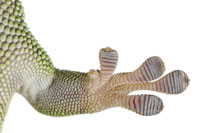Scientists invent ‘Geckskin’, a device capable of holding 700 pounds on a smooth wall.
For years, biologists have been amazed by the power of gecko feet, which allow these five ounce lizards to produce an adhesive force roughly equivalent to carrying nine pounds up a wall without slipping. Now, a team of polymer scientists and a biologist in Alfred Crosby’s polymer science and engineering lab at the University of Massachusetts Amherst have discovered exactly how the gecko manages to do so. This has led them to invent ‘Geckskin’, a device capable of holding 700 pounds on a smooth wall.
What makes geckos’ feet unique
The group includes biologist Duncan Irschick, a functional morphologist who has studied the gecko’s climbing and clinging abilities for over 20 years. He has observed how geckos are equally at home on vertical, slanted, even backward-tilting surfaces. “Amazingly, gecko feet can be applied and disengaged with ease, and with no sticky residue remaining on the surface,” Irschick says. These properties – high-capacity, reversibility and dry adhesion – offer a tantalizing possibility for synthetic materials that can easily attach and detach heavy everyday objects such as televisions or computers to walls, as well as having medical and industrial applications, among others.
This combination of properties at these scales has never been achieved before. Crosby says “Our Geckskin device is about 16 inches square, roughly the size of an index card, and can hold a maximum force of about 700 pounds while adhering to a smooth surface such as glass.”
Beyond its impressive sticking ability, the device can be released with negligible effort and reused many times with no loss of effectiveness. For example, it can be used to stick a 42-inch television to a wall, released with a gentle tug and restuck to another surface as many times as needed, leaving no residue.
How the breakthrough has occurred
Previous efforts to synthesize the tremendous adhesive power of gecko feet and pads were based on the qualities of microscopic hairs on their toes called setae, but efforts to translate them to larger scales were unsuccessful, in part because the complexity of the entire gecko foot was not taken into account. As Irschick explains, a gecko’s foot has several interacting elements, including tendons, bones and skin, that work together to produce easily reversible adhesion.
Now the UMass Amherst team have unlocked the simple yet elegant secret of how it’s done, allowing them to create a device that can handle excessively large weights. Geckskin and its supporting theory demonstrate that setae are not required for gecko-like performance, Crosby points out. “It’s a concept that has not been considered in other design strategies and one that may open up new research avenues in gecko-like adhesion studies in the future.”
The key innovation was to create an integrated adhesive with a soft pad woven into a stiff fabric, which allows the pad to “drape” over a surface to maximize contact. Further, as in natural gecko feet, the skin is woven into a synthetic “tendon”, yielding a design that plays a key role in maintaining stiffness and rotational freedom, the researchers explain.
Importantly, the Geckskin’s adhesive pad uses simple, everyday materials such as polydimethylsiloxane (PDMS), which holds promise for developing an inexpensive, strong and durable dry adhesive.
The UMass Amherst researchers are continuing to improve their Geckskin design by drawing on lessons from the evolution of gecko feet, which show remarkable variation in anatomy. “Our design for Geckskin shows the true integrative power of evolution for inspiring synthetic design that can ultimately aid humans in many ways,” adds Irschick.



